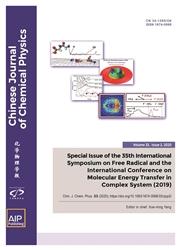难以捉摸的FeV(O)(TAML)反应中间体激活C−H键的机制转换:理论研究
IF 1.2
4区 化学
Q4 PHYSICS, ATOMIC, MOLECULAR & CHEMICAL
引用次数: 0
摘要
本文通过密度泛函理论计算,对Gupta实验中脂肪族底物与芳香族底物的C−H键氧化的不同行为进行了机理研究。我们的计算表明,这种差异是由两种底物(脂肪族环己烷、2,3-二甲基丁烷和芳香族甲苯、乙苯和异丙苯)之间的不同反应机制引起的。对于脂肪族底物,氧化剂FeV(O)(TAML)对C−H的氧化是一个氢原子转移过程;而对于芳香族底物,C−H氧化是一种在过渡态上具有质子转移特性的质子耦合电子转移(PCET)过程,即一种保持类质子转移过渡态的质子耦合的电子转移过程(PCET(PT))。这种差异是由芳香底物的四阴离子TAML环和苯环之间的强π−π相互作用引起的,这具有“拉”效应,使电子从底物向Fe=O部分的转移效率低下。本文章由计算机程序翻译,如有差异,请以英文原文为准。
A mechanistic switch in C−H bond activation by elusive FeV(O)(TAML) reaction intermediate: A theoretical study
The divergent behavior of C−H bond oxidations of aliphatic substrates compared to those of aromatic substrates shown in Gupta's experiment was mechanistically studied herein by means of density functional theory calculations. Our calculations reveal that such difference is caused by different reaction mechanisms between two kinds of substrates (the aliphatic cyclohexane, 2,3-dimethylbutane and the aromatic toluene, ethylbenzene and cumene). For the aliphatic substrates, C−H oxidation by the oxidant FeV(O)(TAML) is a hydrogen atom transfer process; whereas for the aromatic substrates, C−H oxidation is a proton-coupled electron transfer (PCET) process with a proton transfer character on the transition state, that is, a proton-coupled electron transfer process holding a proton transfer-like transition state (PCET(PT)). This difference is caused by the strong π− π interactions between the tetra-anionic TAML ring and the phenyl ring of the aromatic substrates, which has a “pull” effect to make the electron transfer from substrates to the Fe=O moiety inefficient.
求助全文
通过发布文献求助,成功后即可免费获取论文全文。
去求助
来源期刊

Chinese Journal of Chemical Physics
物理-物理:原子、分子和化学物理
CiteScore
1.90
自引率
10.00%
发文量
2763
审稿时长
3 months
期刊介绍:
Chinese Journal of Chemical Physics (CJCP) aims to bridge atomic and molecular level research in broad scope for disciplines in chemistry, physics, material science and life sciences, including the following:
Theoretical Methods, Algorithms, Statistical and Quantum Chemistry
Gas Phase Dynamics and Structure: Spectroscopy, Molecular Interactions, Scattering, Photochemistry
Condensed Phase Dynamics, Structure, and Thermodynamics: Spectroscopy, Reactions, and Relaxation Processes
Surfaces, Interfaces, Single Molecules, Materials and Nanosciences
Polymers, Biopolymers, and Complex Systems
Other related topics
 求助内容:
求助内容: 应助结果提醒方式:
应助结果提醒方式:


